Ibike
USA/Canada Program
|
||
|
|
||
Photo essay: Seattle Ethnic Heritage Bicycle Tour |
||
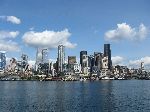 |
(click on photos to enlarge) |
|
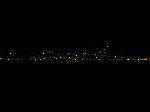 |
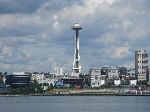
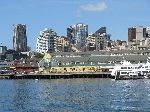
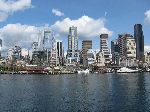
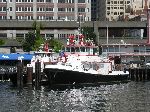 |
|
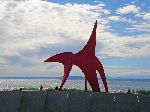
|
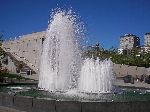
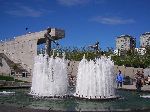
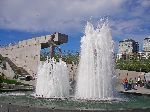
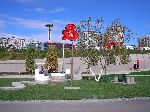 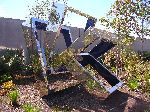 Since
the 1970's Seattle has required that public art be a part of public projects.
While great art can be found throughout the city there is no larger
concentration of outdoor art than at the Seattle Art Museum's Olympic Sculpture
Park. A walking tour is better for giving it the time it is due than a
pass through with bikes, any visit will give you something to thing about. Since
the 1970's Seattle has required that public art be a part of public projects.
While great art can be found throughout the city there is no larger
concentration of outdoor art than at the Seattle Art Museum's Olympic Sculpture
Park. A walking tour is better for giving it the time it is due than a
pass through with bikes, any visit will give you something to thing about.
Shown above are (left to right): Split by Roxy Paine, Sky Landscape 1 by Louise Nevelson; Schubert's Sonata by Mark Di Suvero; and Typewriter Eraser, Scale X by Claus Oldenburg and Coosje Van Bruggen.
|
|

Bicyclists at Myrtle Edwards Park |
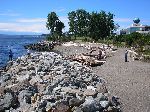 North of Seattle's
central waterfront there is unobstructed access along the shore through
Myrtle Edwards Park and Elliott Bay Park. It is part of the intra-city bicycle
network, a popular route for joggers, and a favorite of the more sedentary crowd
who wants to escape the energy of the city for a while. Beside fresh and
breezy open space, there are good views back into the city North of Seattle's
central waterfront there is unobstructed access along the shore through
Myrtle Edwards Park and Elliott Bay Park. It is part of the intra-city bicycle
network, a popular route for joggers, and a favorite of the more sedentary crowd
who wants to escape the energy of the city for a while. Beside fresh and
breezy open space, there are good views back into the city |
|

|
 Magnolia bluff -- misnamed
because the dominate tree is the Madrona (a.k.a. Arbutus) -- offers a panoramic
view of Puget Sound, several islands and the distant Olympic mountain range. Magnolia bluff -- misnamed
because the dominate tree is the Madrona (a.k.a. Arbutus) -- offers a panoramic
view of Puget Sound, several islands and the distant Olympic mountain range. |
|
 Fisherman's Terminal |
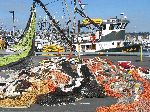 Because of the protected harbor and fresh water, Fisherman's Terminal is the home
of the Alaska fishing fleet -- crab, bottom fishers, purse seine and long line.
Boats also dispatch to the South Pacific. Recently women have gained some
equality in the industry. Fisherman's Terminal hosts the memorial to more
than 460
Seattle fishermen who have been lost at sea since 1900. Sadly ocean fishing is
still a very dangerous occupation. It is a rare year that new names are
not added to the memorial. Because of the protected harbor and fresh water, Fisherman's Terminal is the home
of the Alaska fishing fleet -- crab, bottom fishers, purse seine and long line.
Boats also dispatch to the South Pacific. Recently women have gained some
equality in the industry. Fisherman's Terminal hosts the memorial to more
than 460
Seattle fishermen who have been lost at sea since 1900. Sadly ocean fishing is
still a very dangerous occupation. It is a rare year that new names are
not added to the memorial. |
|

Hiram Chittenden Locks and fish ladder |
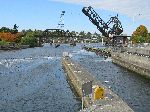 After fifty-five years of controversy and politics on how to connect Puget Sound
to Lake Washington, work finally started on Hiram Chittenden Locks and fish
ladder in 1911. The locks were opened in 1917. They are our gateway
to the historic Scandinavian community of Ballard. Legend is Ballard had to
be as many churches as it did bars, OR, as many bars as churches.
Ballard is Seattle's newest "new bohemia". Popular stops are the Tractor Tavern,
Bop Street Records, the Sunset Tavern, Hattie's Hat. After fifty-five years of controversy and politics on how to connect Puget Sound
to Lake Washington, work finally started on Hiram Chittenden Locks and fish
ladder in 1911. The locks were opened in 1917. They are our gateway
to the historic Scandinavian community of Ballard. Legend is Ballard had to
be as many churches as it did bars, OR, as many bars as churches.
Ballard is Seattle's newest "new bohemia". Popular stops are the Tractor Tavern,
Bop Street Records, the Sunset Tavern, Hattie's Hat. |
|
 |
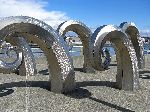 The
site of the locks was formerly a settlement of the indigenous Shilshole band of the
Salish people. This is commemorated by "Salish Welcome" (left) by Marvin Oliver, a
local Quinault/Isleta Pueblo artist. When the Shilshole lived here the
area was renown for clam beds and salmon runs. The clams have been
decimated by development, but the fish ladder has helped the salmon to survive
-- though some of the runs are struggling. At the locks is Paul Sorey's
installation "Salmon Wave" (right). The
site of the locks was formerly a settlement of the indigenous Shilshole band of the
Salish people. This is commemorated by "Salish Welcome" (left) by Marvin Oliver, a
local Quinault/Isleta Pueblo artist. When the Shilshole lived here the
area was renown for clam beds and salmon runs. The clams have been
decimated by development, but the fish ladder has helped the salmon to survive
-- though some of the runs are struggling. At the locks is Paul Sorey's
installation "Salmon Wave" (right). |
|
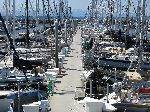 |
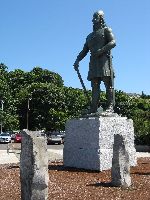 West,
along the open waters of Puget Sound, is the Shilshole marina. The moorage
is primarily occupied by private sail boats. When you do the math it is astonishing
how many millions of dollars of boats are purchase and then paid for to float at
a dock. Many of the boats leave their berths for only a few weeks of the year. West,
along the open waters of Puget Sound, is the Shilshole marina. The moorage
is primarily occupied by private sail boats. When you do the math it is astonishing
how many millions of dollars of boats are purchase and then paid for to float at
a dock. Many of the boats leave their berths for only a few weeks of the year.
In keeping with Ballard's Scandinavian heritage, the great explorer, Leif Erikson surveys the scene from a pedestal on the edge of the parking lot. No one expects that he made it to the Pacific Northwest, but many argue that he captained boats that reached North America before Christopher Columbus. |
|
 Waiting For the Interurban
|
 Fremont (self-proclaimed
"Center of
the Universe") is one of Seattle's most creative neighborhoods. In 1857, John
Ross moved to Fremont and built sawmill. It was platted in 1888, the same year
the Seattle, Lake Shore and Eastern railroad came from Seattle and headed to the
northeast to Lake Washington and beyond. By the next year the hills were clear cut and with
the winter rains they had an ecological disaster. Guy Phinney built the
first street car line from downtown through Fremont to carry visitors up the
hill to his private Woodland Fremont (self-proclaimed
"Center of
the Universe") is one of Seattle's most creative neighborhoods. In 1857, John
Ross moved to Fremont and built sawmill. It was platted in 1888, the same year
the Seattle, Lake Shore and Eastern railroad came from Seattle and headed to the
northeast to Lake Washington and beyond. By the next year the hills were clear cut and with
the winter rains they had an ecological disaster. Guy Phinney built the
first street car line from downtown through Fremont to carry visitors up the
hill to his private Woodland park
in 1890. In 1891, Fremont annexed itself to Seattle. In
1905, the Car Barn was built and in 1910, the
Stone & Webster's Seattle-Everett Traction Co (the Interurban) was inaugurated. But
by 1932 the automobile age was dawning and Aurora Bridge was built to fly over
the top of Fremont and take people to the suburbs. Fremont became a backwater in
the center and the railroads quit in 1939. Fremont was down, but
not out. Forty years later it emerged as a creative node of literary and
visual artist. A few of park
in 1890. In 1891, Fremont annexed itself to Seattle. In
1905, the Car Barn was built and in 1910, the
Stone & Webster's Seattle-Everett Traction Co (the Interurban) was inaugurated. But
by 1932 the automobile age was dawning and Aurora Bridge was built to fly over
the top of Fremont and take people to the suburbs. Fremont became a backwater in
the center and the railroads quit in 1939. Fremont was down, but
not out. Forty years later it emerged as a creative node of literary and
visual artist. A few of
 the quirky attractions are: There is a
resident troll under the sidelined the community. Careful observers will
find the boots of the wicked witch protruding from a large bolder -- presumably
under which she met her demise. Locally famous TV personalities JP Patches
and Gertrude dance on the sidewalk. Rapunzel has been trap in a bridge
tenders tower for
decades -- presumably waiting for one of the thousands of commuters who pass by
daily to rescue her -- most don't even realizing her existence.
A bold and bigger than life Vladimir Lenin, the father of the Russia's socialist the quirky attractions are: There is a
resident troll under the sidelined the community. Careful observers will
find the boots of the wicked witch protruding from a large bolder -- presumably
under which she met her demise. Locally famous TV personalities JP Patches
and Gertrude dance on the sidewalk. Rapunzel has been trap in a bridge
tenders tower for
decades -- presumably waiting for one of the thousands of commuters who pass by
daily to rescue her -- most don't even realizing her existence.
A bold and bigger than life Vladimir Lenin, the father of the Russia's socialist revolution, seems to be stepping out on to Leary Way, perhaps to try and stem
the flow of capitalist traffic, streaming by on the neighborhoods main arterial.
For a brief period some local crafts people had fitted Mr. Lenin with a pair of
knitted gloves.
revolution, seems to be stepping out on to Leary Way, perhaps to try and stem
the flow of capitalist traffic, streaming by on the neighborhoods main arterial.
For a brief period some local crafts people had fitted Mr. Lenin with a pair of
knitted gloves.
(Mr. Leary, for whom the street is named, was a successful developer of private property, and Mrs. Leary was an avid bicyclist.) Fremont's backwater days seem to be behind it; The micro-breweries and their groupies have now swept in (and out), followed by the gentrifying boutiques, services and restaurants. |
|

|
Bicyclists travel on their
stomachs so when a tour passes a meal time we are obliged to sample the local
fare. There is a huge variety of cuisines to choose from.
[For those for which this tour is just the introduction to a two week tour, before we got out of Seattle we will dine on Thai, Ethiopian and Japanese food. Over the coarse of the next two weeks we usually add Korean, Mexican, Italian, Northwest, BBQ, and more Thai and Japanese.] |
|
 |
From the top of "Kite Hill" in Gasworks Park, you get a sweeping view of the
city. In front of the city is Lake Union, the location of "Annie's" (Meg
Ryan) house boat (on the right shore in this picture) in the movie
"Sleepless in Seattle." At our feet is a human-size sundial where the user becomes the gnomon, which cast the shadow showing the time. |
|
 Sadako and 1000 cranes, Peace Park |
 One
of Seattle's most moving monument commemorates Sadako, a young Japanese girl who contracted leukemia
from the Hiroshima atomic bomb (Aug 6, 1945). She was a runner and
collapsed one day at a competition. She wanted to run again so she started folding
1000 origami cranes. Japanese legend says if you fold 1000 cranes your wish will
come true. Unfortunately, she died before she could finish. Her
determination inspired her classmates to continue to fold cranes and work for
world peace. The memorial is a reminder for not giving up on trying to
heal yourself and the world, that it is not easy, and it takes commitment.
Even though the pocket park is surrounded by roads it holds and aura of peace
around it. One
of Seattle's most moving monument commemorates Sadako, a young Japanese girl who contracted leukemia
from the Hiroshima atomic bomb (Aug 6, 1945). She was a runner and
collapsed one day at a competition. She wanted to run again so she started folding
1000 origami cranes. Japanese legend says if you fold 1000 cranes your wish will
come true. Unfortunately, she died before she could finish. Her
determination inspired her classmates to continue to fold cranes and work for
world peace. The memorial is a reminder for not giving up on trying to
heal yourself and the world, that it is not easy, and it takes commitment.
Even though the pocket park is surrounded by roads it holds and aura of peace
around it. |
|
 Drumheller Fountain |
 The
University of Washington was used as the site of the 1909 Alaska, Yukon Pacific
Exposition, which celebrated trade with Asia (and we still are.) Rainier Vista (right)
is one of
the few identifiable features left from that time. (Another is the old
architecture building.) Drumheller fountain was added in 1961. At
one time is was known as frosh pond, but since the University has successful
clamped down on hazing of freshmen for decades, the name and history are
becoming lost -- unless you go on an Ibike Seattle Heritage tour. The
University of Washington was used as the site of the 1909 Alaska, Yukon Pacific
Exposition, which celebrated trade with Asia (and we still are.) Rainier Vista (right)
is one of
the few identifiable features left from that time. (Another is the old
architecture building.) Drumheller fountain was added in 1961. At
one time is was known as frosh pond, but since the University has successful
clamped down on hazing of freshmen for decades, the name and history are
becoming lost -- unless you go on an Ibike Seattle Heritage tour. |
|
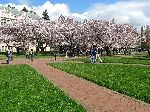 |
Much of the campus is car-free and has a good coverage of trees. The quad is especially beautiful in April when the Japanese Cherry trees are in bloom. Later in the spring, after the trees leaf out, and into the fall, the quad becomes an urban beach were students can simultaneously study and sun, or choose a spot in the shade under the wide canopies of the cherry trees and just study in the open air. | |
 |
 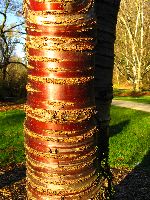 South
of the University of Washington is a necklace of green space -- a network of
large parks connected by green belts. Some of these green belts hosted
bicycle paths for Seattle's bike boom in the late 1800. In the early 1900
the Olmstead Brothers drew up a city wide park plan which incorporated
these facilities and helped to preserve them to this day. One of the larger parks
in the system is the Washington Park Arboretum. South
of the University of Washington is a necklace of green space -- a network of
large parks connected by green belts. Some of these green belts hosted
bicycle paths for Seattle's bike boom in the late 1800. In the early 1900
the Olmstead Brothers drew up a city wide park plan which incorporated
these facilities and helped to preserve them to this day. One of the larger parks
in the system is the Washington Park Arboretum.A lovely side trip is a a stroll through the Japanese Garden. The colors, textures and tones change by the season, as do the hours of operation. Allow at least an hour for a visit. |
|
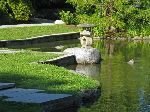
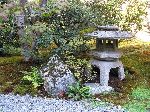
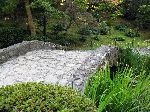
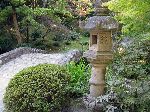
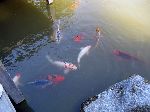
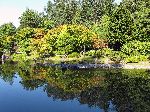
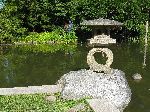
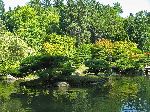 |
||
 Leschi Marina with Mt Rainier |
Some of the eastward development of Seattle was encouraged by developers who built street cars to the their retreats along Lake Washington at Madison Park, Madrona Park and Leschi. Near where the bathhouse / dance studio now stands at Madrona Park there was a hotel, built in 1892. Leschi is the former site of JM Thompson's small amusement park and menagerie (1888), and a cross-lake ferry dock. It was served by Seattle's first cable car. The name is from Chief Leschi who lived in the area with the Nisqually Indians in the early 1800's. In 1855 he refused to sign the Point Elliott Treaty. He was accused of leading a violent a rebellion in 1856, and hanged in 1858 on what are now considered trumped up murder charges. | |
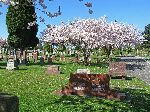 |
A lot of Seattle's history rests in Lakeview Cemetery, on the north end of Capital Hill. Passing through you get a glimpse of Seattle ethnic, religious, occupational diversity, etc. Even the non-notable add to the story, but among the notables are: Princess Angeline (Princess Kikisoblu, daughter of Chief Seattle) (canoe shaped coffin in the plot of Henry & Sarah Yesler), Doc Maynard, Henry Yesler, Dexter Horton (1825-1904), Denny's, Boren's, Chan, Mary Ann Boyer Conklin [Madam Damnable], Hiram Chittenden, Dexter Horton, Thomas Mercer, Captain William Renton. Movie Stars Bruce & Brandon Lee and the remains of 49 Nisei [Japanese-Americans] who died fighting the Axis powers in WWII also can be found here. The old Chinese graves are equally noteworthy. | |
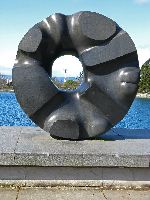 |
Volunteer Park is one of the jewels of the Olmsted park plan of 1903, though it also predated the plan. In 1878, the City of Seattle acquired about 45 acres on north Capitol Hill from James C Coleman, a sawmill engineer, for $2000. The park now honors the veteran volunteers of the Spanish-American War. For the trivia buffs, the park was the site of counterculture "be-ins" during the 60's. It has continued to be popular for summer concerts, fairs and rallies on current issues. One of the most photographed features in the park is Black Sun, by Isamu Naguchi. Without much difficulty you can position yourself so that the Seattle Space Needle is framed by the Black Sun. | |
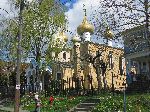 |
Once upon a time Seattle had one Russian Orthodox Church, but then came the Russian Revolution. St. Nicholas (dedicated to Czar Nicholas) parishioners split from St. Spiridon in 1935, after a Bolsheviks allied Father took control of St. Spiridon in the 1920's. Russians came to Seattle in several waves: after the Communist Revolution (1917), when the Japanese conquered Manchuria (1930s), from Russia after WWII (1940s) and after the Chinese Revolution (1947). Architecturally, the five cupolas (domes) symbolize Jesus Christ and the four evangelists. (Seven cupolas might stand for the seven sacraments, and so on.) | |
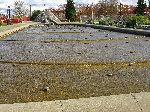 |
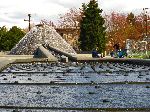 The park that many said would never be used is Cal Anderson Park was delayed for
decades. Now it is one of the most heavily used park on Capital Hill.
Originally the site of a bog, the city started digging the Lincoln reservoir on this site in
1889 and finished 1901. In response to security issues stemming from 9-11-2001
attack,
with money from the Bush Administration, the city quickly changed course and
Lincoln Reservoir was capped and Cal Anderson Park (name for The park that many said would never be used is Cal Anderson Park was delayed for
decades. Now it is one of the most heavily used park on Capital Hill.
Originally the site of a bog, the city started digging the Lincoln reservoir on this site in
1889 and finished 1901. In response to security issues stemming from 9-11-2001
attack,
with money from the Bush Administration, the city quickly changed course and
Lincoln Reservoir was capped and Cal Anderson Park (name for
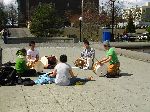 a popular gay state
legislator) was built over it. The park, which opened in 2005, includes a fountain,
texture pool and reflecting pool, promenade paths, landscaping, a shelter house,
a plaza, a children's play area, a wading pool, a lighted sports field, and a
number of oversize chess boards. And sometimes a Korean drum circle (right) or almost
anything else. a popular gay state
legislator) was built over it. The park, which opened in 2005, includes a fountain,
texture pool and reflecting pool, promenade paths, landscaping, a shelter house,
a plaza, a children's play area, a wading pool, a lighted sports field, and a
number of oversize chess boards. And sometimes a Korean drum circle (right) or almost
anything else. |
|
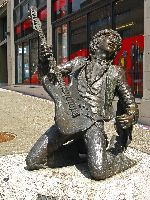 |
Broadway is has so much contrast that it could fill a book. Just on one corner: It always seems a bit ironic that the statue of home grown psychedelic rocker Jimmy Hendrix was
commissioned by Muzak, the corporation that brought you almost invisible
"elevator music" or "wallpaper music". Hendrix, of course, was anything but
audibly invisible. Muzak has moved on, both Looking across the street is "Wind Candle" (right), a reflection that is more likely to have been inspired by the music of John Cage than Jimmy Hendrix. |
|
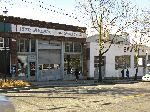 |
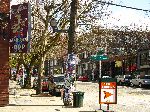 The
Pike/Pine/Broadway corridor became Seattle’s Auto Row shortly after the first
automobile was offered for sale in Seattle in 1905. For the next twenty years
virtually all local auto dealers and numerous auto-related businesses were
located here. Nearly every building housed at least one dealership, service
garage, parts dealer, paint shop or similar business. “Auto Row” thrived with
the strong economy of the 1920s, when this showroom was built. However, the
Great Depression of the 1930s led to general stagnation, and the neighborhood
changed significantly after World War II. As the suburbs grew, most auto
dealerships moved away from the congested city locations, although Volvo and
Ferrari, and a surprising number of parts dealers and service businesses remained. The
Pike/Pine/Broadway corridor became Seattle’s Auto Row shortly after the first
automobile was offered for sale in Seattle in 1905. For the next twenty years
virtually all local auto dealers and numerous auto-related businesses were
located here. Nearly every building housed at least one dealership, service
garage, parts dealer, paint shop or similar business. “Auto Row” thrived with
the strong economy of the 1920s, when this showroom was built. However, the
Great Depression of the 1930s led to general stagnation, and the neighborhood
changed significantly after World War II. As the suburbs grew, most auto
dealerships moved away from the congested city locations, although Volvo and
Ferrari, and a surprising number of parts dealers and service businesses remained. |
|
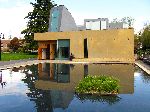 |
Further south on Capital Hill is Steven Holl's award winning Chapel of St Ignatius, on the Seattle University Campus. From SU's website, "Steven Holl chose "A Gathering of Different Lights" as the guiding concept for the design of the Chapel of St. Ignatius. This metaphor describes Seattle University's mission and it also refers to St. Ignatius vision of the spiritual life as comprising many interior lights and darknesses, which he called consolations and desolations." Seattle University is a non-profit Jesuit catholic university founded in 1891. | |
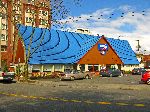 Just
a block away from St. Ignatius is one of Seattle's last remaining International
House of Pancakes or IHOPs. They have in common a raison d'être to
serve the needs of the 10,000 students of Seattle University, albeit different
needs. Just
a block away from St. Ignatius is one of Seattle's last remaining International
House of Pancakes or IHOPs. They have in common a raison d'être to
serve the needs of the 10,000 students of Seattle University, albeit different
needs. |
||
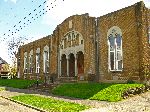 Tolliver Temple (was site of originally Turkish Sephardic Bikur Holim Synagogue, 1910)
|
The Central District was one of Seattle's first suburbs. With street cars and
improved streets it became practical for the middle class and wealthy to escape
the undesirable elements of the downtown. Neighborhoods were largely defined by
there views, but there were large Victorian house throughout the area. There was
some segregation by religion. For the first half of the 20th century there was a
Jewish enclave east of 14th between Yesler and Cherry Streets with several
synagogues, kosher delis and bakeries. Just to the north, Immaculate Conception Church, on 18th and
Marion, was the center of the Catholic Community. With increased motorization the
White communities moved out to the next suburbs. From 1940 to 1950 to 1960, the
White population went from 86% to 60% to 25%. From its earliest development
Black settled in the corridor east along Yesler and north along 23rd. This
included the Black Victorian (elite), who lived in the large Victorian houses.
Later housing covenant in other parts of the city restricted people of color to this area.
This also severed to restrict the groups to a limited choice of schools and
subsequently opportunities. The area went from 9% Black in 1940, to 79% Black in
1970, to 21% Black in 2010. During good economic times the community
thrived (i.e. the jazz seen), but during economic down turns the area became
blights, social problems increased and the community had trouble escaping
downward spirals. The problem was recognized in the 1950, but |
|
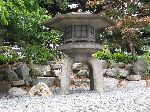
|
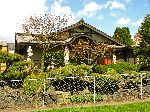 One of the
markers of Japan town is the Kobe Terrace Park. A prominent feature is
the large Yuki Midor ("snow viewing lantern"). The stone lantern and
cherry trees were a gift to Seattle from Kobe, Japan, one of its sister cities.
Hopefully the lantern will fulfill it purpose of lighting the way. One of the
markers of Japan town is the Kobe Terrace Park. A prominent feature is
the large Yuki Midor ("snow viewing lantern"). The stone lantern and
cherry trees were a gift to Seattle from Kobe, Japan, one of its sister cities.
Hopefully the lantern will fulfill it purpose of lighting the way.For
first thirty years at the beginning of the 20th Century, Seattle had a thriving
Japan town, with concentrated array of shops, theatres, bathhouses, restaurants,
hotels and religious institutions serving the community along Main Street
between 4th and There
are other vestiges of Japan town: At the east end, a cluster of Japanese
institutions has reformed since WWII. There are Buddhist temples at 1500
South Main (Betsuin Temple) and South Washington (Koyasan Temple) (upper right), and the
|
|
|
|
||
 |
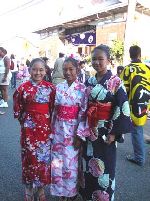
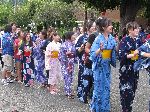 If
you do the tour on the third weekend of July don't miss Bon Odori (a Japanese festival to remember the ancestors and dance).
The annual festival is organized by the Seattle Betsuin Buddhist Temple. The prayers to the ancestors are done
earlier in the day and then the late afternoon and evening are a giant street
dance where many of the participants where magnificent, colorful kimonos and yukatas (a
casual summer kimono usually made of cotton.) If
you do the tour on the third weekend of July don't miss Bon Odori (a Japanese festival to remember the ancestors and dance).
The annual festival is organized by the Seattle Betsuin Buddhist Temple. The prayers to the ancestors are done
earlier in the day and then the late afternoon and evening are a giant street
dance where many of the participants where magnificent, colorful kimonos and yukatas (a
casual summer kimono usually made of cotton.) |
|
 |
It's Seattle's best street dance! If you get their at the right time you can see the Seafair Court (Queen and princesses) or Seafair Pirates. If your and their timing is really great the princesses and the pirates might be there at the same time (photo left). Though this sounds like a recipe for mayhem, Seattle has very refined pirates and their behavior is better than they would lead you to believe -- they walk with a swagger and "aye" with vibrato but it is all smoke and no fire. (Seafair is Seattle's summer long celebration with ethnic festivals, street fairs, parades, sports events and plenty of consumption at each -- by the spectators) | |
 |
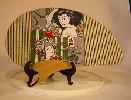
Inside the building of the adjacent Japanese Betsuin Buddhist Temple, you can learn about Buddhism and see displays on Japanese-America history, culture, crafts, ikebana, bonsai and other art. |
|
|
|
||
 |
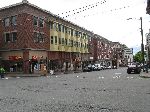 Another
important ethnic group in Seattle's International District is the Chinese.
After a fifty year effort the first of two planned Chinese gates was dedicated
in 2008. Historically, the Chinatown / International District had a large
residential population of immigrant single men. Many of the building in
the district were built in the early 1900's with retail on the first floor and
low-rent, simple, small, single occupancy room upstairs. One-hundred years
later they are starting to be upgraded. Another
important ethnic group in Seattle's International District is the Chinese.
After a fifty year effort the first of two planned Chinese gates was dedicated
in 2008. Historically, the Chinatown / International District had a large
residential population of immigrant single men. Many of the building in
the district were built in the early 1900's with retail on the first floor and
low-rent, simple, small, single occupancy room upstairs. One-hundred years
later they are starting to be upgraded. |
|
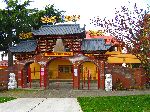 |
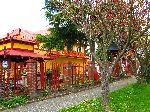 Chua
Vietnam (Vietnamese Buddhist Association of Washington), was the first Vietnamese Buddhist temple in Washington.
Established in 1979, there are services are in Vietnamese, every Saturday at
11am with a free vegan lunch to follow. In Vietnamese culture red and gold
symbolize
both for royalty and the color of skin and blood. Chua
Vietnam (Vietnamese Buddhist Association of Washington), was the first Vietnamese Buddhist temple in Washington.
Established in 1979, there are services are in Vietnamese, every Saturday at
11am with a free vegan lunch to follow. In Vietnamese culture red and gold
symbolize
both for royalty and the color of skin and blood. |
|
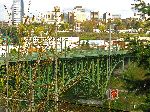 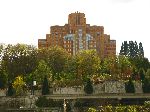 |
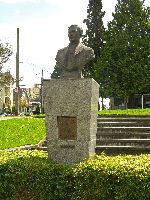 The
Lushootseed (Salish language) word for Beacon Hill is qWátSééch, meaning
"greenish-yellow spine," perhaps referring to the ridge and the deciduous trees.
Since then a quarter mile of ridge has been dug into a canyon and replaced by a
bridge (top left). The bridge is named after Jose Rizal (right), an
intellectual, physician, author, and national hero of Philippines, who was
martyred by Spanish authorities in 1896. The
Lushootseed (Salish language) word for Beacon Hill is qWátSééch, meaning
"greenish-yellow spine," perhaps referring to the ridge and the deciduous trees.
Since then a quarter mile of ridge has been dug into a canyon and replaced by a
bridge (top left). The bridge is named after Jose Rizal (right), an
intellectual, physician, author, and national hero of Philippines, who was
martyred by Spanish authorities in 1896.
Where the greenish-yellow ridge picks up again it is dominated by a well liked art deco edifice of many histories: It started serving in 1934 as a Marine Hospital, then a Public Health Service Hospital and then Pacific Medical Center. In the 1990's part of it became the administrative headquarters of Amazon.com. They too have now moved on. |
|
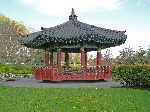 |
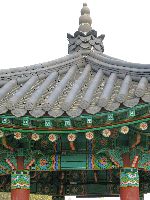 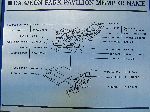 The Daejongjeong
(Daejon Park pavilion), in Daejon Park, was a gift to Seattle from its South Korean sister city, Daejon.
For those who want to bone-up on the Korean term for the architectural features
there is a convenient sign with a diagram and the names in English and Romanized
Hangul (Korean). The Daejongjeong
(Daejon Park pavilion), in Daejon Park, was a gift to Seattle from its South Korean sister city, Daejon.
For those who want to bone-up on the Korean term for the architectural features
there is a convenient sign with a diagram and the names in English and Romanized
Hangul (Korean). |
|
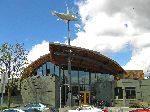 |
Floating above the Beacon Hill Library is the "Dream Ship" weather vane. The art could be because so much of the population who originally settled in the neighborhood came to the city on their own personal "dream ship", or because the books in the library can be like "dream ship" that takes the reader to distant lands, or it is a statement about dreams floating in the wind or turning in the wind. How would you use a dream ship? | |
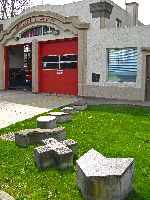 "Tidal Wave Story" by Ellen Ziegler.
|
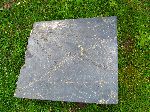 At the fire
station the art installation is the "Tidal Wave Story", recounting a Japanese saga of fire doing good.
Each pedestal contains a line of the tale: At the fire
station the art installation is the "Tidal Wave Story", recounting a Japanese saga of fire doing good.
Each pedestal contains a line of the tale:
|
|
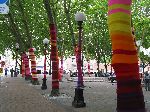 |
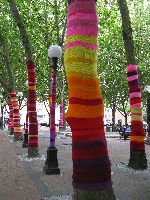 In the summer of 2011 tree socks or tree sweaters, or knitted graffiti, appeared
in several towns in the Northwest. The knitted art installation shown here
is in Occidental Park in Seattle's Pioneer Square historical district. It was a cold summer
until the last weeks of August so a little extra insulation might have been
welcomed by the trees -- not sure what advantage the extra layer provided for
the light post. Other knitted graffiti in Seattle have included a fire
hydrant and gloves of a statue of Lenin. In the summer of 2011 tree socks or tree sweaters, or knitted graffiti, appeared
in several towns in the Northwest. The knitted art installation shown here
is in Occidental Park in Seattle's Pioneer Square historical district. It was a cold summer
until the last weeks of August so a little extra insulation might have been
welcomed by the trees -- not sure what advantage the extra layer provided for
the light post. Other knitted graffiti in Seattle have included a fire
hydrant and gloves of a statue of Lenin. |
|
| Click here for details on half-day or full-day custom bicycling or walking Seattle Heritage Tours | ||
|
|
||
|
"Hosted by
DreamHost - earth friendly web hosting"
|
||
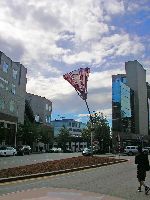
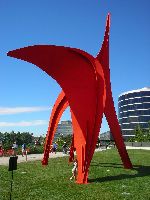
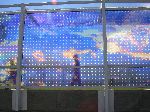
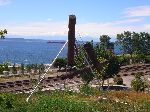
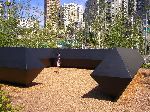
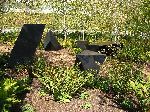
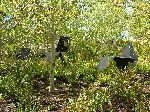
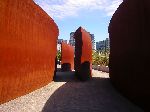

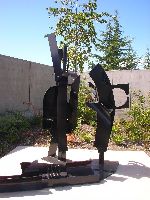
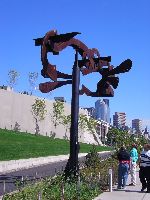
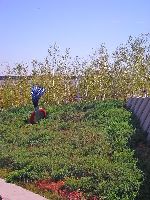


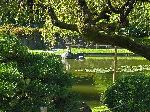
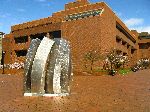
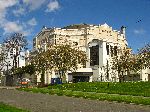
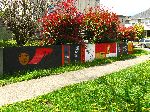
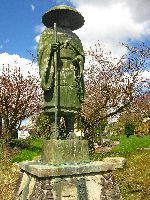
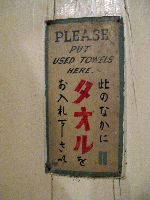
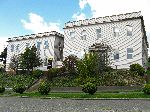
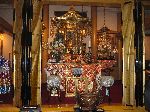
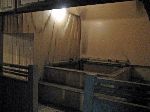
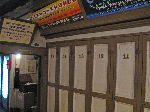
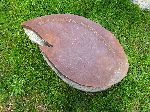
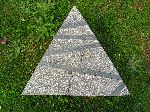
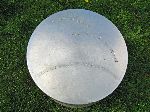
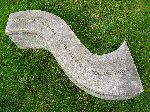
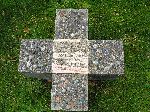
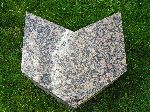




 Please
contact us
Please
contact us